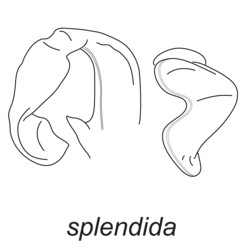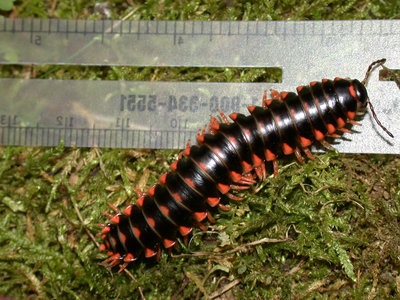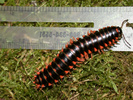Brachoria splendida
The Splendid Mimic Millipede
Paul MarekCharacteristics
Brachoria splendida individuals are about 47.7 mm long and 10.8 mm wide (females 47.08 mm X 10.87). Color: 3-spotted yellow, pink or red (shown above); striped yellow (rare); and combined striped/3-spotted yellow (rare).


Brachoria splendida genitalia - left male gonopodal acropodite (with setae removed): (Left) medial view and (Right) magnified apical view. © Paul Marek

Brachoria splendida, 3-spotted yellow color morph. © Paul Marek
Habitat
Brachoria splendida is common in the Appalachian mixed mesophytic deciduous forests along Pine Mountain in Kentucky. It occurs in upland forests comprising oak, maple, tulip poplar, sycamore, and sassafras (e.g., Kentenia S.F. localities); and in moist lowland forests comprising hemlock, birch, umbrella magnolia, and rhododendron (e.g., Hemlock Garden, Cawood, and Blanton Forest). Other xystodesmids encountered sympatrically at these localities are: Brachoria hansonia (Hemlock Garden), B. flammipes (Cawood), B. gracilipes and B. badbranchensis (Bickford Nature Preserve), and Cherokia georgiana latassa (Kentenia S.F. localities). Note: Individuals of B. splendida may be confused in the field with B. hansonia, B. flammipes, B. gracilipes, B. badbranchensis and C. georgiana latassa due to similarity in color pattern.Distribution
Brachoria splendida occurs predominately on Pine Mountain, a linear mountain ridge, from Kentucky Ridge State Forest in Bell County to about 55 air km northeast to James E. Bickford Nature Preserve in Harlan County, Kentucky. Brachoria splendida also occurs in two apparently disjunct populations in Cumberland Gap National Park and in Daniel Boone National Forest, Leslie County. The closest known Brachoria species, B. hansonia and B. flammipes, co-occurs with B. splendida in Pine Mountain State Park and Daniel Boone N.F.Conservation status
Brachoria splendida is threatened by habitat loss due to agriculture (especially growing demand for paper products), coal mining, development, and the invasion of exotic species.References
Marek P.E. 2010. A revision of the Appalachian millipede genus Brachoria Chamberlin, 1939 (Polydesmida: Xystodesmidae: Apheloriini). Zool. J. Linn. Soc. 159: 817-889.
Causey N.B. 1942. Six new diplopods of the family Xystodesmidae. Ent. News 53: 165-170.
Chamberlin R.V. 1947. Some records and descriptions of diplopods chiefly in the collection of the Academy. Proc. Acad. Nat. Sci. Philadelphia 99: 21-58.
Chamberlin R.V., Hoffman R.L. 1958. Checklist of the millipeds of North America. Bull. U.S. Nat. Mus. 212: 1-236.
Keeton W.T. 1959. A revision of the millipede genus Brachoria (Polydesmida: Xystodesmidae) Proc. US Nat. Mus. 109: 1-58.
Hoffman R.L. 1999. Checklist of the millipeds of North and Middle America. Virginia Museum of Natural History Special Publication. No. 8. Martinsville: Virginia Museum of Natural History.
Title Illustrations

| Scientific Name | Brachoria splendida |
|---|---|
| Location | USA, Kentucky, Leslie Co. |
| Reference | Marek P.E. 2010. A revision of the Appalachian millipede genus Brachoria Chamberlin, 1939 (Polydesmida: Xystodesmidae: Apheloriini). Zool. J. Linn. Soc. 159: 817-889. |
| Specimen Condition | Live Specimen |
| Sex | m |
| Life Cycle Stage | adult |
| View | dorsal |
| Collection | FMNH |
| Collector | Paul Marek |
| Image Use |
 This media file is licensed under the Creative Commons Attribution-NonCommercial License - Version 3.0. This media file is licensed under the Creative Commons Attribution-NonCommercial License - Version 3.0.
|
| Copyright |
© Paul Marek

|
About This Page
Work on the millipede Tree of Life pages was supported by a U.S. National Science Foundation Doctoral Dissertation Improvement Grant to Paul Marek and Jason Bond (DEB 0607996) and a Partnerships for Enhancing Expertise in Taxonomy Grant to Petra Sierwald, Jason Bond, and William Shear (DEB 0529715).
Paul Marek

Virginia Polytechnic Institute and State University
Correspondence regarding this page should be directed to Paul Marek at
Page copyright © 2010 Paul Marek
 Page: Tree of Life
Brachoria splendida . The Splendid Mimic Millipede.
Authored by
Paul Marek.
The TEXT of this page is licensed under the
Creative Commons Attribution-NonCommercial License - Version 3.0. Note that images and other media
featured on this page are each governed by their own license, and they may or may not be available
for reuse. Click on an image or a media link to access the media data window, which provides the
relevant licensing information. For the general terms and conditions of ToL material reuse and
redistribution, please see the Tree of Life Copyright
Policies.
Page: Tree of Life
Brachoria splendida . The Splendid Mimic Millipede.
Authored by
Paul Marek.
The TEXT of this page is licensed under the
Creative Commons Attribution-NonCommercial License - Version 3.0. Note that images and other media
featured on this page are each governed by their own license, and they may or may not be available
for reuse. Click on an image or a media link to access the media data window, which provides the
relevant licensing information. For the general terms and conditions of ToL material reuse and
redistribution, please see the Tree of Life Copyright
Policies.
- First online 16 September 2010
- Content changed 16 September 2010
Citing this page:
Marek, Paul. 2010. Brachoria splendida . The Splendid Mimic Millipede. Version 16 September 2010 (under construction). http://tolweb.org/Brachoria_splendida/144232/2010.09.16 in The Tree of Life Web Project, http://tolweb.org/








 Go to quick links
Go to quick search
Go to navigation for this section of the ToL site
Go to detailed links for the ToL site
Go to quick links
Go to quick search
Go to navigation for this section of the ToL site
Go to detailed links for the ToL site